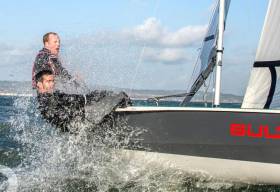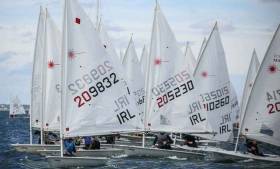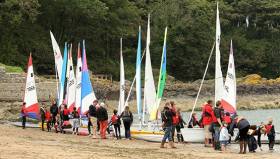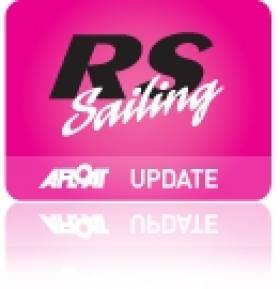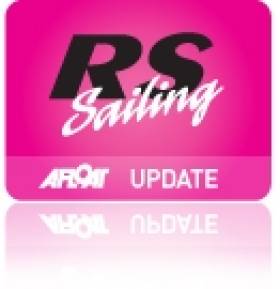Displaying items by tag: Royal North of Ireland Yacht Club
RS400 'Frostie' Series Kicks off on Belfast Lough
The start of the RS400 winter racing season begins at 2pm on Sunday at the Royal North of Ireland Yacht Club on Belfast Lough. The annual RS400 Frostie Series, has grown over the years and this year the club expects to have over twenty boats lining up on the start line which is great for any double-handed class.
There will be three back to back races every Sunday. The beauty of it is that the races are short sprint style windward leeward’s with only two laps which makes it fun and exciting. The racing will go right up until Sunday 23rd December where the winner will be crowned and presented with the Trophy.
"The annual RS400 Frostie Series, has grown over the years and this year the club expects to have over twenty boats lining up"
Past winners have included Liam Donnelly & Rick McCaig, Trevor D’Arcy & Ginge, Robert Hastings & Rory Higgins and last year Paul McLaughlin and Own McKinley from Cushendall picked up the Bosun Bob’s Trophy.
So who is also in the mix this year? Bob Espey is getting in back in the saddle joined by Richard McCullough. Bob is a past winner of many of the regional events and one to watch. Barry Mac who has been dabbling with Fireballs, is joined up front with Andrew Penny. Chris and Jess Penny have a fairly fresh boat and aim to have the fleet behind them. Tiffany Briens & Oli Loughhead are joining forces this year and they have reportedly been out practicing. Hammy Baker will be back and has a newer boat. Sam Pickering, new to the fleet this year will be joined by Simon Martin. Peter Kennedy & Stevie Kane fresh from winning the “All Ireland Sailing Championships” are hoping to put some manners on the young bucks.
RNIYC will be hosting the UK & Irish RS400 Nationals in August 2019, many crews have this well in their sights so will be using the Frostie Series as good practice. It is expected there will be one more boat purchased before the year is out.
Lynch, McMahon & Higgins Crowned Ulster Laser Champions at Royal North of Ireland Yacht Club
Ireland's youngest ever Olympic helmsman won three of six races to be crowned Ulster Laser Champion yesterday at Royal North of Ireland. Finn Lynch, of the National Yacht Club, had a four point margin with six top three results but was chased hard by Ballyholme's Liam Glynn, who also had a consistent score sheet with five results in the top three to finish on 11 points. Kinsale Yacht Club's Darragh O'Sullivan was one point back to take third in the 13–boat fleet. Both Lynch and Glynn are on the Tokyo 2020 campaign trail, and benefited from a week of competition at the Sailing World Cup in Hyeres immediately before the Ulster event.
Full results in each division are downloadable below.
The breeze on Belfast Lough held very well over the weekend despite fears to the contrary. At eight to 13 knots, a mainly easterly wind had predictable shifts with a short and choppy sea for the combined turnout of 116–boats in three divisions.
As Afloat.ie reported earlier, there were not many surprises in the six–race Radial division with Howth's Ewan McMahon staying top of the 32–boat fleet. Wexford Boat Club's Ronan Wallace was second with Aoife Hopkins of Howth Yacht Club third. A visting Norwegian girl Elnan Flotoft finished sixth.
Royal St. George's Tom Higgins was very quick in the 4.7 division with a scoresheet resembling Finn Lynch's. Higgins, a past UK and Irish Optimist Champion, had three race wins to be seven points clear of club mate Jack Fahy. Kinsale's Michael Caroll was third in the 24–boat fleet.
Just before the presentation of prizes got underway yesterday at the Fireball Ulster Championships in the Royal North of Ireland Yacht Club at Cultra the race officer Alistair Hunter asked to say a few words. It was one of those odd moments, nobody knew what was coming.. In the event he paid the fleet a huge compliment by declaring the Fireball racing at the Ulsters amongst the most competitive he had ever seen. He went on to say that he was astonished that there wasn’t a one recall over the six race event and yet about half the fleet shot through the start line at full speed bang on the gun every time.
The level of competition was remarkable given that a relatively small ten boat fleet made it up to the Ulsters. The event was dominated by Noel Butler/Stephen Oram who won five of the six races, and by Conor and James Clancy snapping at their heels with one bullet and a string of seconds. But the rest of the fleet immediately behind enjoyed extremely close racing. It was nip and tuck throughout the event with places changing on each leg of the courses and several finishes with a second or two between a string of finishers.
After a shaky start on Saturday the weather gods looked kindly upon the fleet – the first race took place in a very light westerly in an odd breeze which had all the hallmarks of a light thermal fighting a light gradient wind. It was snakes and ladders all the way up the beat until suddenly a Northerly kicked in. Spinnakers were hoisted and as the fleet converged on the mark from all directions a rib came charging down to declare the race abandoned. Quickly the PRO reset the course and the fleet got three decent races in, with enough pressure to allow trapezing on the beats. With a filling tide on Saturday most boats headed inshore to the shallows but the usual play-off between pressure, wind-shifts and tide applied so there was plenty to think about.
On Sunday with an earlier kick-off three races were sailed in a strong Northerly and an ebbing tide, and getting out into deeper water and a better tide was the way to go, except of course when it wasn’t! Again there were options, the chop in the middle of the course was hard work and by the second race in particular the breeze in the middle had gone patchy while there was a decent vein of wind to be harvested on the southern shore. By race three the tide was flat but pressure had improved again in the middle, proved by Louise McKenna/Hermine O’Keeffe who took out three boats by a foray to the left, and bagging a fourth place finish into the bargain.
Second overall in the event were the Clancy brothers with Niall McGrotty/Neil Cramer a deserving third with consistent third and fourth place finishes in most races. Behind them Michael Ennis/Marie Barry had a very good event at 4th overall in Ennis’s old home waters, and Alan Henry/Simon Revill on equal points showed that though relatively new to the fleet they are very quickly working their way up through the ranks. Frank Miller/Grattan Donnelly showed early promise with a 3rd place finish in the first race but had a mixed second day which left them in 6th overall. Neil Colin/Margaret Casey were 7th, Louise McKenna/Hermine O’Keeffe 8th and Dara McDonagh/Neil Duke took the silver trophy over Ulster sailors Brian O’Neill/Craig Ossler, both sailing classic Fireballs.
Overall this was a superb event – the race officer delivered the fastest race turnarounds the class has ever seen, and his proactive management of the marks for wind variation between rounds and his time management was superb. One race came in at exactly the suggested 60 minutes, another at 57! The club itself delivered warm and efficient hospitality under event director Fenton Parsons. On the Saturday night the class sat down to a fine curry in the private dining dining room followed by entertainment by the Pikestone Preachers , with Fenton double-jobbing as drummer with his band. The next regional event is the Open event in Wexford on July 3rd/4th, but club racing continues in DBSC and in Killaloe and a scattering of Fireballs are expected out in the Dun Laoghaire regattas.
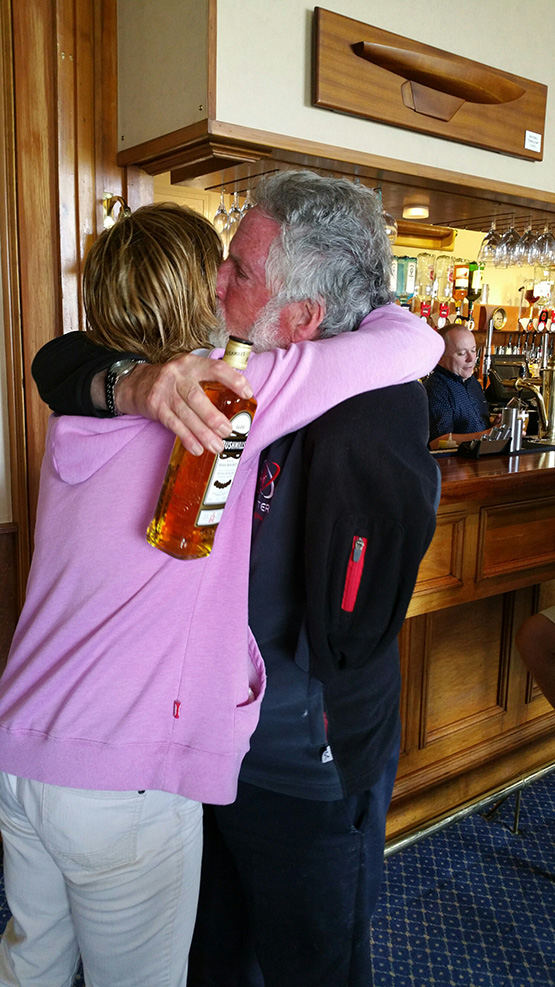
(above) Race officer Alistair Hunter gets his just reward from class chairman Marie Barry; and (below) second and third overall with event director Fenton Parsons. Photos: Frank Miller
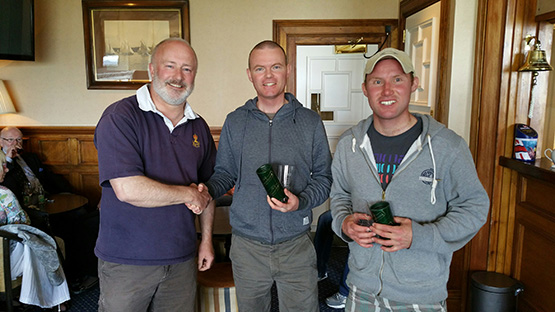
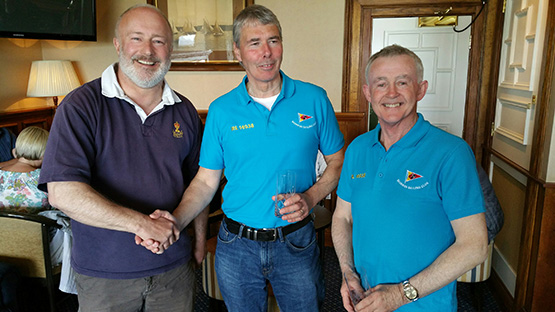
There was a time when the local sailing club was a social centre for children, where they got their first ‘taste’ of sailing as a ‘fun’ and enjoyable occasion without the stress of competition and performance separating them from each other, based on their “sporting prowess.”
In the past few weeks I have learned from readers and listeners who have contacted me that there is more than one aspect of exclusivity about sailing and my opening description this week is compiled from what I have been told since I first expressed concern that the public perception of elitism in sailing may be excluding a wider coterie of people from participation in the sport.
The Irish Sailing Association has responded with the launch of the ‘Try Sailing Programme’ and a number of clubs have introduced Crew Point’ for newcomers to be introduced to the sport, which are positive initiatives, but ‘sailor/parents’ have referred me to their concerns that representative “squads” and “teams” lauded by clubs can deter youngsters who do not reach the perceived sporting parameters from continuing in the sport..
There is a dichotomy between the desire of clubs to be well represented nationally, which builds their reputations and similarly, for Ireland to do the same at international level, which necessitates identifying and developing high performers. Sailing is not the only sport needing the sustenance of success, but what about maintaining the interest of those who do not aspire to or succeed at the higher levels? Clubs are not founded on the success of “squads,” or “teams” or individual “stars” but on strong committed ‘ordinary’ members, the foundation for the future.
The Vice-Commodore of Royal North of Ireland Yacht Club, based at Holywood, Co.Down, is Michael Meharg, who has been telling me about the development of the concept of the ‘Regatta Club’ on Belfast Lough, mixing fun, the sociability of sailing and a gentle introduction to racing for young sailors, while at the same time increasing club membership, participation and introducing newcomers to the sport:
“You are probably aware of the RYA's "Push the Boat Out" initiative, encouraging "come and try it" days at the various yacht clubs? My club, RNIYC, has been running these days for the last five years with good results. We are holding our next one on May 22.”
He went on to tell me of a bigger concept, currently being launched, called ‘Regatta Club’ with a focus on young sailors. Michael is an RYA Senior Instructor with 30 years’ experience of training children, is easy to listen to and explains the concept well on this week’s THIS ISLAND NATION PODCAST, which you can hear below.
“As you rightly point out, a lot of organisations are racing-focussed and in my experience, many of the youngsters coming out of their first courses have neither the experience nor confidence to go straight into racing/squad training and prefer to sail for the fun and sociable side of things. If these opportunities are not there, we lose them! At the same time, Regatta attendance in Belfast Lough has been declining for some time now.”
Regatta Club’ aims to encourage youngsters from 8-to-18 years into "sociable sailing” and, perhaps, return to those days when children loved to go down to ‘the club’ to go sailing and the sport captured their lifetime interest as a result. Saturday, June 4, off Grey Point in Helen’s Bay, is the inaugural event and there is an open invitation to Afloat readers.
- Listen to the podcast below.
RYA Northern Ireland Youth Sailing Championships at Royal North
Entry to the RYA Northern Ireland Youth Championships and NI Schools Cup closes shortly and the RYA is urging as many youth sailors to enter as possible. Northern Ireland's premier Youth and Junior Sailing event will be hosted at Royal North of Ireland Yacht Club on 26th & 27th September 2015.
The event will offer youth and junior sailors high level competition as well as accessible training and coaching through a RYANI coach supported regatta fleet.
Competitors are invited to race in the Optimist, Topper, Topper 4.2, Mirror, Feva XL fleets if they are under 16 as of 31st December 2015, and may compete in Laser 4.7, Laser Radial and 420 fleets if they are under 19 as of 31st December 2015.
The event will also act as an indicator for all sailors interested in being selected for RYANI Junior and Youth Squads.
Squib Northerns Won By Driscoll & Cagney
#squib – With weather and wind conditions that ranged from light and shifty to strong and gusty, the Rodgers & Browne Irish Squib Northerns took place last weekend (30/31st May) at the Royal North of Ireland Yacht Club. After very competitive and tight racing, John Driscoll and David Cagney on Aficionado took the title of Northern Champions.
A total of 18 boats competed with entries from the home club, Strangford Lough and all the way down to Cork. It was great to see so many squibs on the start line with a very high standard of fleet, including past Olympians, National and Northern Champions. At the end of day one the championship was very much open, leaving it all to play for on the Sunday. The conditions were tough and the race team, under the guidance of Nigel Kearney, skilfully managed to set five good races to complete the series.
On Day one, and under light conditions, race one started and with much jostling John Driscoll and David Cagney on Aficionado took first place ahead of David Eccles and Phil Hutchinson on Inshallah, Peter Kennedy and Gavin Vaughan on Joint Venture and Gordon Patterson and Ross Nolan on Quickstep III. Wyatt Wright and James Porter on Fat Boat Slim and Killyleagh boat Robert Marshall and Ryan Withers on Slipstream all putting in good performances within the top ten
Race two saw the Patterson/Nolan pairing on Quickstep III take line honours from Greg Bell and Leah McCleave on Prodigal and Des Clayton and Paul Henry on Inismara sailing a great race to take third. Johnny Miller and Sally Watson on High Flyer and Cork boat Too Dee sailed by Dave Sheehan and Carol Ann Rohan were both close to the lead at times during a race which had some massive shifts.
Race three saw a slightly stronger 10 knot breeze coming from the south, but this did nothing to remove those shifts. Eccles/Hutchinson on Inshallah were over the line early, went back, and with a nice left shift led the race on lap one from Greg Bell and John Driscoll with Gordon Patterson in fourth position. But with shifty conditions Greg bell on Prodigal got through and extended to win the race. Race three also saw Johnny Park and Bob Stinson on Gizmo climbing their way up the fleet.
Day two dawned with very different wind conditions. With dark foreboding skies, heavy rain showers and a late night the night before, a couple of competitors opted out of sailing and decided to stay on land!
Nigel Kearney got the reduced fleet racing started with a good clean start from all competitors. There was great close racing and first to round was George and Philip Cromie on Dotzboat from Killyleagh, liking the conditions. Fred Campbell was next on Halloween, Joint Venture and followed by Des Clayton on Inismara fourth. The windy condition suited new faces with new competitors appearing in the top ten. As the fleet rounded the windward mark for the second time, Joint venture led with a nice calm hoist by Andrew Vaughan, taking over from his Dad, Gavin in the crew spot. Aficionado worked up the fleet to round second following a perfect lift up to the layline, then Quickstep with a great hoist by Ross Nolan ahead of Fred Campbell on Halloween. Peter Kennedy and Andrew Vaughan on Joint Venture won, Aficionado second and Quickstep III in third position.
The fifth and final race saw Aficionado leading on the left of the beat but under pressure from Joint venture and Quickstep III, with Quickstep delaying the tack to come in late on the layline and sneak the lead from Aficionado. By the second round, Aficionado was in the lead from Joint Venture heading downwind when a big 35-knot squall covered the race course. Some boats got their kites away in time, others held on for some fun surfs, but there were a few knock downs and broaches in the fleet, with Halloween in sixth place going over and filling up with water very quickly. In the end John Driscoll and David Cagney on Aficionado won a very close final race and took championship by four points from Peter Kennedy and the Vaughans, with Gordon Patterson and Ross Nolan in third position.
Full results downloadable below :
1st Aficionado 78 RNIYC John Driscoll David Cagney
2nd Joint Venture 64 RNIYC Peter Kennedy Andrew & Gavin Vaughan
3rd Quickstep III 820 RNIYC Gordon Patterson Ross Nolan
4th Prodigal 146 RNIYC Greg Bell Leah McCleave
5th Inshallah 139 RNIYC David Eccles Phil Hutchinson
Did The America's Cup Destroy Belfast Lough Sailing?
#americascup – The 35th America's Cup series will be staged in Bermuda in 2017, and already the first team – Ben Ainslie Racing – is starting to settle into its base in the islands at the beginning of a developing process which, it is hoped by locals, will contribute significantly and sustainably to an economy which is by no means as prosperous as the popular image of Bermuda would suggest.
Yet past experience of being involved with the America's Cup circus suggests that while there are definitely immediate and highly visible benefits, they're ephemeral and are more than offset by a hidden but very definite downside. And the pace of the event at its peak is at such a level that almost immediately afterwards there's a sense of anti-climax and recrimination which can poison a sailing centre's atmosphere for years. W M Nixon considers how sailing's most stellar event affected Irish sailing, looks at a more recent continuation of this story, and then takes up the tale of an old boat whose class's health suffered collateral damage from America's Cup fallout.
It was while tracing the story of Tern, a 37ft William Fife-designed Belfast Lough One Design built by John Hilditch of Carrickfergus in 1897, that we stumbled into what is arguably an example of the America's Cup having a seriously damaging effect on local sailing.
Somehow or other, Tern has survived, and is currently being restored to international standards in Palma, Mallorca. But it was when a couple involved with her restoration came to Ireland shortly after Christmas to spend some time researching her history that we had to face the fact that while Belfast Lough's involvement with the America's Cup is seen as a glamorous and still-celebrated era, as far as everyday sailing is concerned it did little but harm.
The context is intriguing. Belfast in 1897 was the Mumbai of its day. From a population of around 80,000 in 1850, by 1910 its unprecedented expansion through massive industrial innovation and development, built largely around ship-building and linen manufacturing, had seen numbers soar towards 300,000. The city was a byword for pollution, over-crowding, and ill health, but equally it was noted as a place where anyone with energy and an innovative manufacturing idea was expected to have made their fortune within ten years, and around three or four years to start reaching towards wealth was seen as a not unreasonable aim.
In such a frenetic and ambitious atmosphere, sailing on Belfast Lough developed apace, and it developed ambitiously and competitively for all that the lough, while providing splendid sailing water, lacked any really good natural anchorages. New boats and new boat types appeared with bewildering rapidity, and a sort of one design keelboat concept was being accepted by the early 1890s in order to make good racing accessible to keen young men at a reasonable price. There may have been much underlying wealth about, but spending it on extravagances like large and expensive yachts was frowned upon.
By 1896 a young whiskey distiller called James Craig (he later became Lord Craigavon) was promoting the idea of a strict One Design keelboat around 23ft LOA, and about 16ft LWL, designed by the great William Fife in Scotland, but built on the lough by John Hilditch at his Carrickfergus boatyard. As the pioneer of the concept in the locality, Craig called the new class the Belfast Lough No. 1 OD, but the first boat to the design, his own Fugitive, was barely finished before the One Design keelboat ideal was taken up with enthusiasm by another group which decided they wanted something to the same concept, but much larger.
These new boats, the first of which were rapidly built in time for the 1897 season, were almost exactly enlarged versions of Fugitive, but were all of 37ft overall and 25ft waterline. In a case of Might is Right, the bigger boats now became the Belfast Lough Number Ones, while Fugitive and her sisters were demoted to Number 2, and by the early 1900s they'd slipped still further to become the Number 3s when yet another class appeared, this time around 31ft LOA.
There were enough of the new 37ft Number Ones afloat to make a real impact on Clyde Fortnight in 1898, and as they were well able to sail across Channel to do so, they were arguably the world's first offshore one design. The previous year, some had visited Dublin Bay, where they so impressed the locals that they were the inspiration for the Dublin Bay 25s, to the same lines but built to a higher specification and with lead ballast keels, rather than the Belfast Lough boats' cast iron keels.
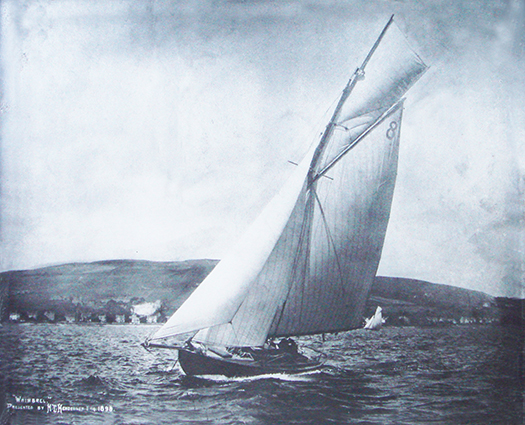
Whimbrel on the Clyde in 1898. They'd the potential to be the world's first offshore one design, but offshore racing hadn't yet been invented. Whimbrel is currently undergoing restoration in Bordeaux. Photo courtesy Gordon Finlay/RUYC
By the middle of the 1898 season, the Belfast Lough One Designs were in all their glory, and our header photo from that season shows a class which surely promised at least a decade of great racing. Yet their peak years barely stretched beyond the turn of the century, and within five years they scarcely existed as a class. Well before the Great War broke out in 1914, they were starting to spread near and far in a scattering which was to continue post war and in most cases ended up in their eventual demise. But remarkably, two have survived and both are undergoing restoration, Whimbrel Number 8 in Bordeaux and Tern, number 7, in Mallorca.
Patricia O'Connell and Alan Renwick live in Palma where he is a master craftsman with Ocean Refits while she – a former Honorary Secretary of a Georgian preservation society in Dublin – has undertaken the tracing of Tern's story, as Tern's restoration is Alan's current project. They arrived in Dublin in the dying days of 2014, and by the time they headed back to Palma well into January, they'd spent time in Cork and Northern Ireland following the old boat's elusive trail, and had also called in Howth to see Ian Malcolm's Howth 17 Aura, which was built in Hilditch's yard within a year of the construction of Tern.
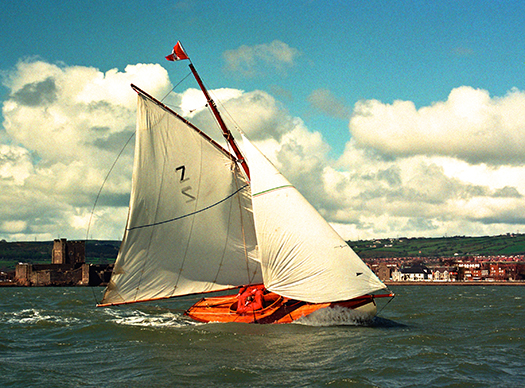
Still going strong. The 1898 Hilditch-built Howth 17 Aura off Carrickfergus Castle for her Centenary, April 1998. With her sister-ships, she then sailed the 90 miles home to Howth. Like Tern, she is number 7 – and like Tern, there's an element of confusion with sail number 2. Photo: David Jones
The original five Carrickfergus-built Howth 17s still sail together as part of a thriving class of twenty Howth 17s. But the impressive class of eight Belfast Lough One Designs from the same era have been remembered for more than a hundred years only as photos on the walls of the Royal Ulster Yacht Club. What went wrong?
The America's Cup – that's what went wrong. In the early years of sailing's premier trophy, there was remarkable Irish involvement. After the schooner America won it with a race round the Isle of Wight in 1851, it took a while to establish a format for races to try and wrest it back from the New York Yacht Club in contests in America. During the 1870s, there were three challenges – two from Britain and one from Canada. Then in the 1880s there were three from Britain and one from Canada, the final one from Britain in 1886 being through the Royal Northern YC of Scotland, but that was because the owner's wife was Scottish – the husband was Lt William Henn whose family home was on the north shore of the Shannon Estuary.
But while the Henn family's hefty cutter Galatea was another unsuccessful challenger, at least she was seen in the waters of the Shannon Estuary. Yet although the first two challenges in the 1890s were by racing machines owned by a yachtsman whose ancestral pile was also on Shannonside, neither boat was seen anywhere near Adare Manor, the home of Lord Dunraven on the south side of the Shannon Estuary, whose two campaigns in 1893 and 1895 were unsuccessful and increasingly acrimonious.
With the passage of time, it becomes increasingly clear that Dunraven got a decidedly raw deal. But in the feverish atmosphere of rapid economic expansion in the 1890s, the world was more interested in pushing ahead with new projects rather than putting right old wrongs. Someone who saw the developing publicity and business potential in the America's Cup was Thomas Lipton, the Scottish-born grocery magnate whose American empire was thriving with a combination of his sheer love of hard work, and gift for publicity.
Lipton had noted the extraordinary level of public interest in Lt & Mrs Henn's "family" challenge in 1886 – they'd actually lived on board the Galatea at he time. But much more importantly, he'd noted the international crisis which arose from the Dunraven affair, and cannily realized that anyone who could smooth the waters with a good-tempered America's Cup challenge would attract acres of favourable coverage, regardless of the actual result.
That said, as a highly competitive individual, there's no doubting he was keen to win. But even though all five of his yachts called Shamrock making his America's Cup challenges between 1899 and 1930 were unsuccessful, with some being much more closely fought than others, he remained resolutely good humoured throughout, and expansion of his retail empire continued unabated. But what's less widely known is that while the America's Cup Shamrocks were numbered I to V, there was a sixth Shamrock, an un-numbered 23 Metre, which raced as his private yacht. It's said that when she didn't perform as well as she should have, the old man could be very grumpy indeed.
But that's all in the future. Here we are in the latter half of the 1890s, and on Belfast Lough this wonderful new class of 37-footers is spreading its wings, thriving on the fact that although the owners lived all round the lough and were members of one yacht club, the Royal Ulster YC founded 1866 and given the "Royal" in 1869, they could feel at home wherever their boats happened to be, as the RUYC had no clubhouse. This was a true sailing club, fixed only to good sailing water, and with the Belfast Lough Number Ones they could sail it well.
It was too good to last. Thomas Lipton was a man in a hurry. He knew that he needed a yacht club of international standing through which to make his first America's Cup challenge. But as he was of humble birth and very much in trade instead of benefitting from inherited wealth, there were few yacht clubs open to him. However, his parents had come from Monaghan, not only in Ireland but particularly in Ulster. In the can-do atmosphere of Belfast in the 1890s, it was indicated that the Royal Ulster might be receptive to his interest. He was soon a member, and plans were roaring ahead for an 1899 Challenge with Shamrock I.
But the RUYC had taken a cuckoo into its nest, or rather its virtual nest. It emerged that a virtual nest was not enough for the aspirations of a serious America's Cup challenger, he needed a real nest. Lipton was soon insisting that his America's Cup challenge, now irreversibly under way, would required the RUYC to have a proper clubhouse impressively sited above the waters of Belfast Lough where it was assumed he would very soon be the defender in the America's Cup.
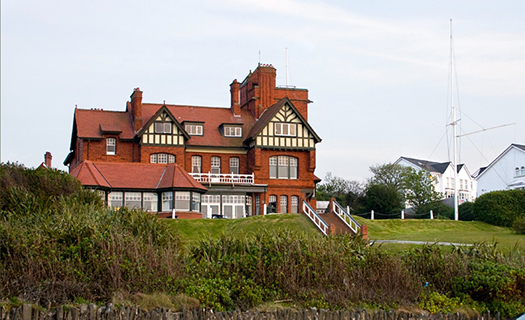
The new RUYC clubhouse was completed at the behest of Thomas Lipton in 1899 after just 18 months work.
And he got his way. An impressive arts and crafts tower-topped clubhouse design was drawn up by James Craig's brother, the architect Vincent Craig, and the new RUYC clubhouse was opened in April 1899, having been built in 18 months flat. Well – not quite flat. They were in such a hurry for completion that there wasn't the time to entirely level the hillside site on the Bangor waterfront where the new clubhouse was built, and even today the ground floor is on two or three different levels.
That said, it's an impressive building to have been put up in such a short time, and somehow they achieved a sort of instant antiquity with it – today it seems much older than its 116 years, and it has always been thus.
But antique or otherwise, it doesn't seem to have been desired by all the members. There were 150 of them, yet only 30 contributed directly to the cost of the new clubhouse. And others took their sailing elsewhere. We live in hope of finding letters or a sailing diary from this period which will tell us what was really going on, for official club committee papers only cover what was on the agenda and recorded in the minutes. Thus even if there was an almighty row going on about the very fact of the somewhat cavalier building of this new clubhouse, at the time it would have been something known to everyone, and talked about by everyone, yet not written down simply because everyone knew of it, and it didn't happen to be directly pertinent to the business of the day. And anyway, once the clubhouse was in being, that was that – the best thing was to get on with living with it.
Yet the fact is that a distinct division arose in sailing along the south coast of Belfast Lough. The conspicuous Royal Ulster YC in Bangor became the public face of yachting in the area. But further up the lough at Cultra beside a roadstead anchorage, what had been a modest canoe club developed in 1899 into an amalgamation of the Ulster Sailing Club with the Cultra Yacht Club to become the North of Ireland Yacht Club, and by 1902 – by which time Lipton had already unsuccessfully challenged twice for the America's Cup through RUYC – the new place at Cultra had become the RNIYC, with a modest clubhouse aimed exclusively at serving its members' sailing needs rather than following grandiose ideas of international yachting campaigns for plutocrats who were only very seldom about the place, if at all.
Inevitably some of the best sailing men in the north were involved with this move to Cultra where many had always anchored their boats in any case, and others had followed. Whether or not the active membership of the RUYC was seriously depleted we can only guess. But the fact is that the relatively small membership of a provincial yacht club had somehow to find, within its membership, the essential people with the necessary talent and experience to provide the back up committee and officer services for Lipton's America's Cup Challenges, with the next one coming along as soon as 1903.
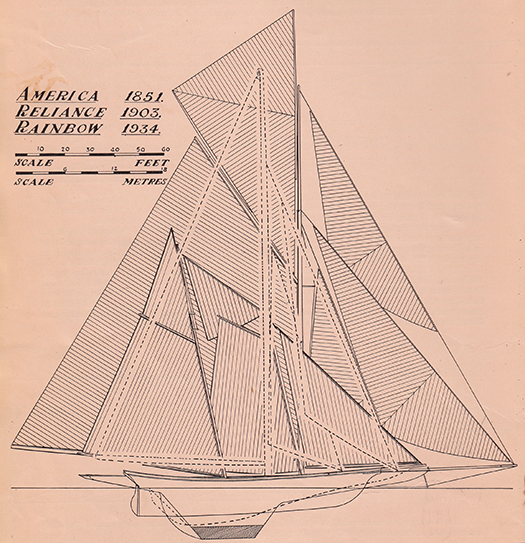
America's Cup design development 1851 to 1930. The Challenge Committee of the RUYC may have come on the scene 48 years after the era of the schooner America, but they still had to cope with the challenges posed by the design development from boats like Reliance in 1903 to the J Class Rainbow in the 1930s.
The drain on RUYC personnel resources was heavy in an era when time-consuming Transatlantic voyages by ship were required for the challenger's committee to meet with the committee of the defending New York Yacht Club. Something just had to give, and it seems to have been the level of personal sailing within RUYC, and particularly with the Number One Class.
The new RNIYC setup at Cultra was establishing its own modest new 22ft OD class, the Linton Hope-designed Fairy Class (also built by Hilditch), so they may well have seen the much larger Number Ones as simply too large, and tainted by the new vulgarity of the RUYC. Whatever the reason, the Belfast Lough Number One Class was a brilliant flame which burned only briefly as a class, even though the boats survived individually with most of them becoming fast cruisers.
But as for the America's Cup, it continued on its melodramatic way, with skulduggery par for the course. After 1903's unsuccessful challenge, when Shamrock III found herself ill-matched against the hyper-giant Reliance, the RUYC committee may have returned home to recuperate and gather strength for Lipton's next campaign. But he was scheming other ideas, and it has been only relatively recently discovered that, unbeknownst to RUYC, he was in preliminary negotiations with the Royal Irish YC on Dublin Bay to organise his fourth challenge.
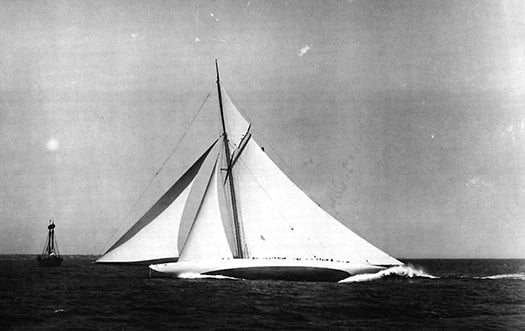
Lipton and the RUYC thought they'd an impressive boat with the Fife-designed Shamrock III in 1903, but this is what they came up against in America – mega-boat Reliance
From a purely commercial point of view, you can understand his thinking. The formerly despised Irish community in the US was expanding rapidly in numbers and prosperity by 1904. Coming in with a challenge through the Royal Irish Yacht Club would hit more market targets than the narrower appeal of a Royal Ulster challenge. It was crude but shrewd business thinking. But fortunately for goodwill in the sailing community, nothing came of it. Challenge 4 through RUYC was slated for 1914, but with the Great War breaking out it was held off - with the radical and very promising Shamrock IV designed by Charles E Nicholson stored in the US – until 1920, with Shamrock IV defeated by the narrowest margin. And then in 1930 came the last challenge, the first with the J Class, but again there was defeat, this time for Shamrock V.
And thus 1930 saw the end of the Royal Ulster YC's tumultuous three decades affair with the Holy Grail of sailing. Since then, other clubs have had their collective finger burnt by the America's Cup. But it usually promises more than it gives. Most recently, sailing has been bluntly reminded of its limited appeal as a spectator sport, even when packaged as America's Cup Plus. The 34th series in San Francisco may have provided some of the most exciting racing ever seen in the event's 164 year history. It made great television for aficionados. And it may have attracted 150,000 shoreside spectators over the length of the series. But let's get it into perspective. San Francisco's Number One tourist attraction is Alcatraz. This island with its former prison fortress linked to the likes of Al Capone and other adornments of American society attracts around a million visitors a year. No matter which way you slice the numbers, that's quite a few more than the America's Cup, it doesn't cost nearly as much, and it's much less trouble to run.
Which goes some way to explain why those of us who live for this crazy old vehicle sport of ours retreat into the happy dreamworld of old boats and their winding journeys through life, often to a wonderful re-birth. And the story of Tern is a classic of its kind. From Belfast Lough she headed some time or other to Cork, we don't quite know when, but we do know she was converted to a yawl for greater ease of handling in 1914. And she was certainly in Cork in the 1920s and 1930s owned seemingly by a loose syndicate, as different owners appear at different times depending on what event she is being entered for, and in 1929 she was one of five yachts taking part in the Irish Cruising Club's Founding Cruise-in-Company to Glengarriff, owned by Capt P F Kelly.
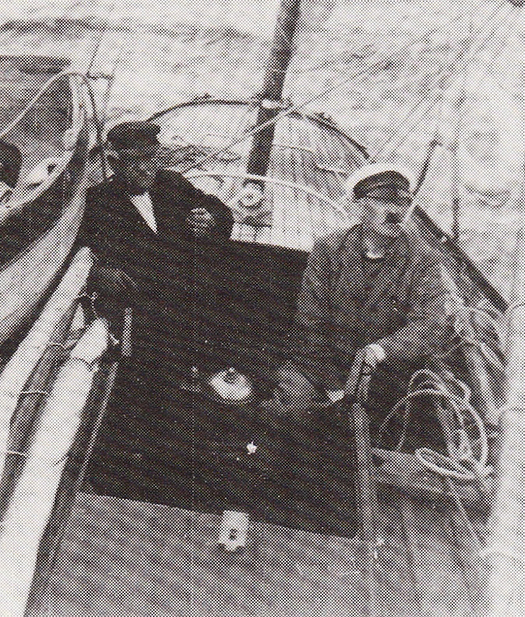
Happy days. Aboard Tern in cruising style, complete with enormous dinghy on the starboard deck, on her way to the founding of the ICC in Glengarriff in 1929 with Captain Kelly and Dr Dan Donovan enjoying the sail
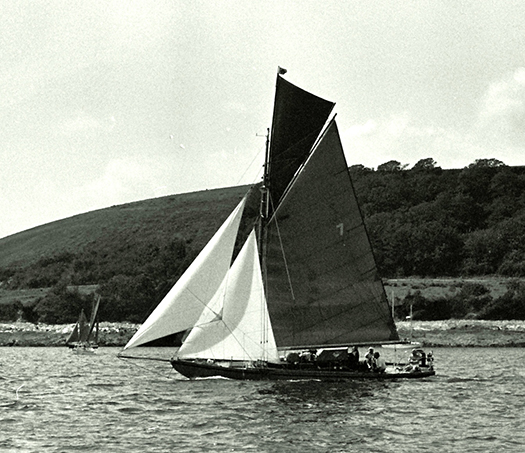
Tern in Falmouth, July 1990. Rot had long since set in within her long and elegant Fife counter, so it had simply been chopped off. Photo: W M Nixon
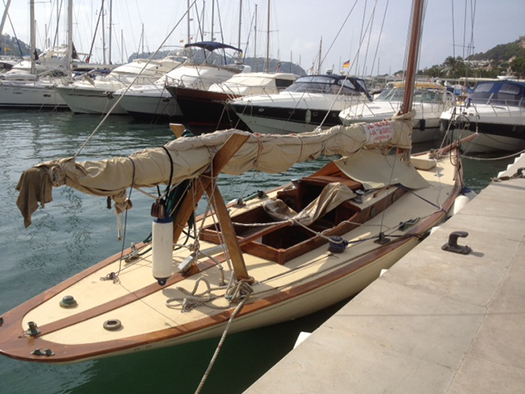
Tern being overcome by the heat in Andraitx in Mallorca, October 2012. Photo: Patricia Nixon
Yet by 1947 according to Lloyds Register she was in Dun Laoghaire, owned by two members of the National Yacht Club, C E Hogg and M Healy. And then she turns up in Falmouth Harbour in the 1970s and stays there for some time, but she was restored to being a cutter, not with full rig but her mizzen had to be done away with, as there was rot in her long elegant Fife counter, so it was simply chopped off to become like a Laurent Giles stern.
It was then in a little yard in a hidden creek off Falmouth Harbour that she had her first major restoration, and with that she went to the Mediterranean. But by the Autumn of 2012 she was seen in Andraitx looking a bit sorry for herself, and very much for sale. And there she was bought and taken into the specialist yard in Palma, and at the end of December 2014 Patricia O'Connell and Alan Renwick turned up in Ireland and began a pilgrimage.
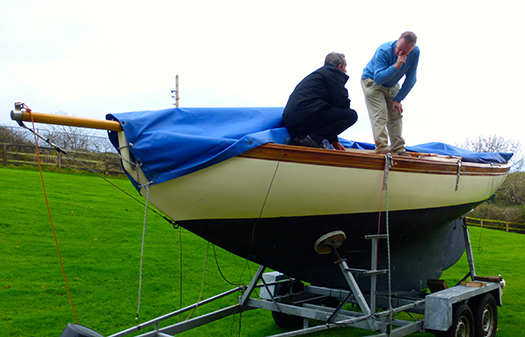
Alan Renwick and Ian Malcolm aboard the latter's Aura in Howth, December 30th 2014. Aura had Tern have just one year age difference, but the same builder. Photo: W M Nixon
This took them to Howth to see the Hilditch-built Aura (like Tern, she's number 7, and like Tern, at one time her mainsail was mixed up with a number 2). Then it was down to Crosshaven to meet Royal Cork archivist Dermot Burns, who was a fund of information and original material abut Tern's twenty-plus years on Cork Harbour. Then on north to Belfast Lough for a large gathering in the Royal Ulster, a party built around the Charley family, one of whose ancestors owned Tern in 1910, and also brought in folk like noted northern sailing historian Michael Clarke of Lough Erne, and Fife yachts historian Ian McAllister who now lives in Carrickfergus. So you can well imagine that information and ideas overload was a constant risk. But Patricia and Alan survived, they got back to Palma in one piece, the work on Tern resumed, and the Tale of Tern goes on.
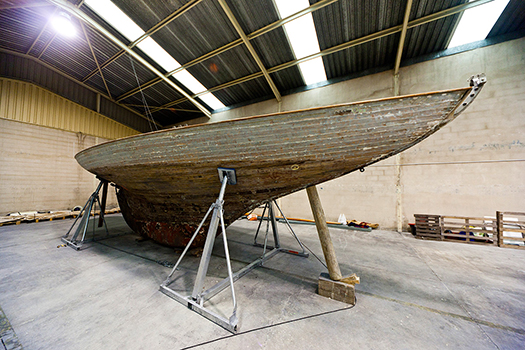
There's a Fife hull in there somewhere. Tern in the restoration shed in Palma
RS Sailors Take to Belfast Lough for Royal North's Autumn Series
#rssailing – RS Sailor David Cheyne reports from Day four of Royal North Ireland's (RNIYC) Autumn Series on Belfast Lough.
You know the way you can want something so badly that you can convince yourself it is something entirely different, well that is what happens when you haven't sailed for 4 weeks due to a truculent weather God, and the relaxed kite pop in 15 knots turns out to be an underestimate by about 100% as you nearly shoot out the back of the boat..... Well, after a drifter on the first Sunday and a couple of hurricanes' backsides on Days 2 and 3, racing of a sort got underway at last at RNIYC today, in a rather fruity 15-29 knots of sunshiney gloriousness.
Why would you sail a simple single hander when you can sail something much more complicated and thus amplify the opportunity for snarl ups, as ably demonstrated by Chrs Penney, who arrived late, with no sheets. Once the appropriate strings had been commandeered from a variety of sources, the Irish Champion, taking time out from his intensive youth squad coaching duties (i.e. Boat preparation, racing tactics etc) promptly yotted off to the race area under limited control, due to his tiller extension not being attached to his tiller, really....
Lots of bits fell off today, including Laura O'Hallorahoolahan, from 1230, and the evergreen Ginge from 825, launching himself unnaturally skyward, into a high tariff dive which drew no applause from Trevor D'Arcy, who was probably wondering if getting back into the class again was going to be as simple as it might have been. For some reason the old timers also decided to drop their kite by pulling the pole out of the front of the boat and cutting the launch line.... always carry a sharp knife when big boat sailing – old habits die hard. Slot gaskets were inspected by all, and by some, such as Dr Hutch and Stuart A, repeatedly, despite Dr H's assertion that No More Nails was just as good as the correct glue. Well I can tell you that it doesn't work as well, and my temporary fix using NMN at Mounts Bay finally succumbed to the endless high wind battering we have had since then, to deliver another fine torrent of foamy sea through the middle of my cockpit. Boat preparation is key it seems.
So onto racing, because that was why we were there, albeit those ashore having lunch might have queried what exactly we were all up to. 12-14 ships set out, and in charge if cat herding was as ever, our long suffering Race Kommandant, Gerry Reid. After giving up waiting for all the boats to be the right way up at the same time, hostilities were commenced, with only one boat capsized on the start line as the sequence started (probably a tactic). Entering the fray, rather later than planned, were Charlie and Wendy, hosing in at mach 2, with their pink kite slightly dictating play, demonstrating that it was still pretty windy. Not sure what happened then, as they came third, so presumably got her spun round in double quick time. Boshing upwind in 20+ knots, DrC and Stevie K punched out a few lengths, and approaching the first mark went for a conservative rounding, which was of course, a red rag to our very own Dick Turpin, Uncle Liam, who saw the gap and snuck through to take the lead. Some fishing by DrC allowed Liam to extend quickly, before a game of hunt the leeward mark broke out. The cleverly camouflaged buoy, sea green in colour, was eventually spotted deeper than expected, taking all the excitement out of the run. Well, there was of course the option of sending it and popping a couple of gybes, but that seemed unwise, and everyone bumbled boringly to the bottom of the course. Lap 2 got a bit livelier again, and it all kicked off at the second top turn, as the gauge strained and, as DC went all softy and declined to pull the trigger on the hoist, the lemmings behind all sniffed a chance, as chutes were launched. This prompted Uncle Liam and Johnny O to stack it and send it over the handlebars, followed by everyone else, who seemed to think this was part of the game. A healthy lead thus established, DrC further embarrassed his family by tacking around at the gybe, providing a good view of the swimming competition behind.
As it looked worse than it was, the rescue cavalry arrived, including the Start/Finish RIB, only to discover that everyone was in fact enjoying the communal activity, leaving Dr C to round the last mark, with no line to finish at. True to form, our erstwhile mobile Race Officer reappeared like Mr Ben, as the leaders arrived at the finish, and rewards were handed out to Dr C/ Steve, and then the two lady crew, with Laura and Paul in second, and Charlie and Wendy in third. The rest all bumbled in thereafter, and with Gerry declaring the whole thing unwise, we all headed for shore. Well, we were meant to, only it was too much fun, so kites were hoisted here there and everywhere, as we all, rather unhelpfully, to the safety teams, went for a quick last blast before bedtime. No harm done, and apologies duly offered and accepted by the Race Team, I think.
Day 6, races 2-4, Report
15 races scheduled so far, one completed, things could only get better, and so it came to pass, the sun came out, the wind appeared from a glassy lough, and we were offski. Crew swapping done, leaving Liam to speak to his attorney, we headed off for a jolly good bunfight in the shiftless NE 5-7 knots, albeit too light for any injuries or embarrassing scenarios to arise.
DrC nipped out in Race 1 of the day, and a procession ensued, Darcy in first loser spot, followed by event sponsor Bosun Bob, of the little shop on the corner opposite the Marina, doing a great pre-Christmas deal on ships in a bottle. Not a very exciting race really, but it served to double the achievement to date.
Race two was a bit more of a shuffle, with traffic jams at the bottom mark leading to inversions of order, and some shoddy roundings by most. Darcy snuck through by taking the great circle route round the fence stallers, jumping up 4 spots to take the lead coming to the top for the second time. DrC made some ground and tried to snare the men from Carrick, but missed the catch, momentarily, before managing to poke them up the bum with his pole, and conceded to a quick spin to relieve the impropriety. Bit more shuffling and Paul McLaughlin nipped through to take the first of his two first-loser slots of the day. Darcy rumbled on to take the biggest rosette.
Race three was abandoned half way up the beat, after a 30 degree leftie as the start gun fired confused everyone, and left Cushendall man McLaughlin leading the lopsided fleet in a straight line to the first mark. Some felt this to be the right decision by Gerry Reid, our erstwhile Race Officer, though Paul knew fine rightly it was because he was from Cushendall.
Determined to flick his thumb off the underside of his top teeth at the process, Paul promptly raced into a lead in the final race of the day, and looked to have it in the bag, when a masked man on a galloping horse made an unexpected appearance, riding in to pinch it off him.
The day's top performer was probably Bosun Bob, with some great speed and a very consistent 3,4,4, showing his blue boat has clearly exorcised the demons of his red hull of yore.
Steady Force 4 and blue skies on the cards next Sunday, so bring it on again in a week.
Results sheet downloadable below.
RS400s Take to Belfast Lough for Royal North Series
#rssailing – 13 RS 400s came to the Royal North of Ireland line yesterday, with boats coming from Cushendall, Dublin and Ballyholme. The RNIYC series runs for another six weeks, breaking for Christmas, then starting again for 12 weeks as the 'Frosties'.
#squib – Reigning Irish Squib keelboat champions James and Bruce Matthews from Kinsale Yacht Club will battle with past winners and recently crowned Eastern Champions, John Driscoll/David Cagney, and Northern Champions, David Eccles/Michael Wright, all of whom are in contention for the main Irish Championship prize at Royal North of Ireland Yacht Club.
As Afloat previously reported, the Rodgers & Browne Squib Irish Championship, supported by North Down Borough Council, will be held on Belfast Lough over the 9th - 11th August and will attract Squibs from throughout Ireland to compete for the trophy.
The Squib Class is one of the largest one design keelboat classes in Ireland. It is sailed by two people and is well known for its distinctive brown sails. Over the
last decade fleets have flourished at Killyleagh Yacht Club, Quoile Yacht Club, Royal St George Yacht Club and Kinsale Yacht Club, in addition to the traditional strongholds of Cultra and Howth Yacht Club.



























